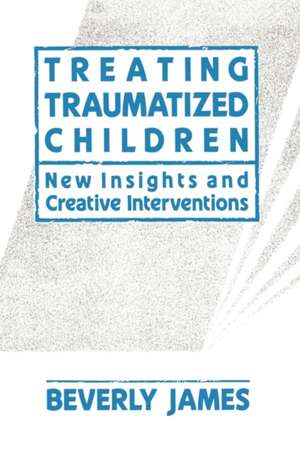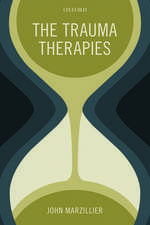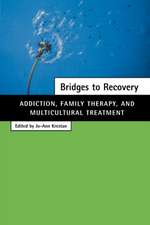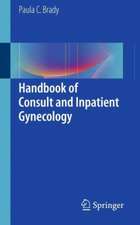Treating Traumatized Children
Autor Beverly Jamesen Limba Engleză Paperback – 22 ian 2009
Treating Traumatized Children is the first handbook to provide specific guidance and tools for treating children who have been traumatized by physical and sexual abuse, disaster, divorce, or witnessing violent events. This book will provide helping professionals with a clear blueprint for assessing the impact of trauma and developing specific treatment plans.
Beverly James, a specialist in evaluating and treating traumatized children, outlines creative exercises and techniques that will enable clinicians to join with children in slowly and carefully reviewing their experiences and helping them understand and accept their feelings related to the trauma. Art, play, and drama techniques, among others, are presented in a sophisticated yet straightforward style, useful to clinicians with specialized training in such techniques or those using them for the first time.
Preț: 124.31 lei
Preț vechi: 130.85 lei
-5% Nou
Puncte Express: 186
Preț estimativ în valută:
23.79€ • 25.94$ • 20.06£
23.79€ • 25.94$ • 20.06£
Carte disponibilă
Livrare economică 03-17 aprilie
Preluare comenzi: 021 569.72.76
Specificații
ISBN-13: 9781439157343
ISBN-10: 1439157340
Pagini: 290
Dimensiuni: 152 x 229 x 20 mm
Greutate: 0.66 kg
Ediția:09000
Editura: Free Press
Colecția Free Press
ISBN-10: 1439157340
Pagini: 290
Dimensiuni: 152 x 229 x 20 mm
Greutate: 0.66 kg
Ediția:09000
Editura: Free Press
Colecția Free Press
Notă biografică
Beverly James is a clinical social worker who has specialized in evaluating and treating traumatized children for the past twelve years. She has authored a number of articles and coauthored Treating Sexually Abused Children and Their Families. Currently director of the James Institute in Kona, Hawaii, her training skills have brought her national and international recognition.
Extras
Chapter 1
What Is Trauma?
Trauma, to paraphrase Webster's New Collegiate Dictionary, is an emotional shock that creates substantial, lasting damage to an individual's psychological development. As used in this book, "trauma" also refers to overwhelming, uncontrollable experiences that psychologically impact victims by creating in them feelings of helplessness, vulnerability, loss of safety, and loss of control. Although other emotional reactions may be seen (or may exist and not be seen), these are the states most likely to be present and to be uncovered by a clinician. The child victim may exhibit severe psychiatric symptoms or may superficially appear symptom-free.
The impact of an event in a child's life cannot be assessed in isolation.
An event traumatic to one youngster may be just a bad experience to another, or it may be traumatizing at one stage in life and not traumatizing earlier or later. The experience may, in fact, be a challenge to some children, who are strengthened by having met the challenge and coped with their situations. The child's constitution, temperament, strengths, sensitivities, developmental phase, attachments, insight, abilities; the reactions of his loved ones; and the support and resources available to him, all contribute to how an event is experienced, what it means to the child, and whether or not it is traumatizing at that specific time in the child's life.
The traumatizing event may be a single occurrence such as witnessing violence or an injury to self, or a series of interactions which, in totality, is traumatic. Examples might include incest, a long exposure to deprivation, a prolonged custody battle, surviving an airplane crash, or seeing people killed during war. The trauma may be directly physical, such as involvement in an accident, or solely psychological, as may occur when a child witnesses a disaster in which people are killed or injured, or when a parent whispers erotic longings to him.
Children have always been traumatized. It is only recently, however, that researchers and clinicians have begun to pay special attention to the effects of trauma on children -- attention that is probably an outgrowth of social, political, and technological changes. Reporting systems and communication improvements have brought about an awareness of the widespread sexual abuse of children. Post-traumatic stress disorder has been identified in Viet Nam war veterans. The women's movement has brought us to a greater awareness of the problems of rape and incest. Trauma is not new, but how we recognize and deal with it is new.
Research suggests that the impact of trauma on a child may have lifelong psychobiological consequences, depending on the developmental stage of the child at the time of trauma, his coping abilities, and the meaning of the event to the child. As research continues and theories are developed and refined, we should expect new implications for treatment that will assist the clinician in working with these children.
Copyright © 1989 by The Free Press
What Is Trauma?
Trauma, to paraphrase Webster's New Collegiate Dictionary, is an emotional shock that creates substantial, lasting damage to an individual's psychological development. As used in this book, "trauma" also refers to overwhelming, uncontrollable experiences that psychologically impact victims by creating in them feelings of helplessness, vulnerability, loss of safety, and loss of control. Although other emotional reactions may be seen (or may exist and not be seen), these are the states most likely to be present and to be uncovered by a clinician. The child victim may exhibit severe psychiatric symptoms or may superficially appear symptom-free.
The impact of an event in a child's life cannot be assessed in isolation.
An event traumatic to one youngster may be just a bad experience to another, or it may be traumatizing at one stage in life and not traumatizing earlier or later. The experience may, in fact, be a challenge to some children, who are strengthened by having met the challenge and coped with their situations. The child's constitution, temperament, strengths, sensitivities, developmental phase, attachments, insight, abilities; the reactions of his loved ones; and the support and resources available to him, all contribute to how an event is experienced, what it means to the child, and whether or not it is traumatizing at that specific time in the child's life.
The traumatizing event may be a single occurrence such as witnessing violence or an injury to self, or a series of interactions which, in totality, is traumatic. Examples might include incest, a long exposure to deprivation, a prolonged custody battle, surviving an airplane crash, or seeing people killed during war. The trauma may be directly physical, such as involvement in an accident, or solely psychological, as may occur when a child witnesses a disaster in which people are killed or injured, or when a parent whispers erotic longings to him.
Children have always been traumatized. It is only recently, however, that researchers and clinicians have begun to pay special attention to the effects of trauma on children -- attention that is probably an outgrowth of social, political, and technological changes. Reporting systems and communication improvements have brought about an awareness of the widespread sexual abuse of children. Post-traumatic stress disorder has been identified in Viet Nam war veterans. The women's movement has brought us to a greater awareness of the problems of rape and incest. Trauma is not new, but how we recognize and deal with it is new.
Research suggests that the impact of trauma on a child may have lifelong psychobiological consequences, depending on the developmental stage of the child at the time of trauma, his coping abilities, and the meaning of the event to the child. As research continues and theories are developed and refined, we should expect new implications for treatment that will assist the clinician in working with these children.
Copyright © 1989 by The Free Press
Cuprins
Contents
List of Illustrations and Tables
Preface
Acknowledgments
1. What Is Trauma?
2. Critical Aspects of Treatment
Returning to the Pain
Developmentally Sequenced Treatment
Involvement of Child's Caregivers
Direct, Open Approach
Intense, Fun Style
Multidimensional Strategy
Hidden Trauma-Reactive Behaviors
Therapist's Responses to Children's Experiences
Summary
3. Traumagenic States to Be Considered in Treatment Planning
Self-Blame
Powerlessness
Loss and Betrayal
Fragmentation of Bodily Experience
Stigmatization
Eroticization
Destructiveness
Dissociative/Multiple Disorder
Attachment Disorder
Summary
4. Guidelines for Evaluation and Treatment Planning
Clarifying Needs, Expectations, and the Therapist's Role
Physical Examination
Comprehensive Background Information
Parent Interviews
Collateral Interviews
Child Assessment
Written Report
Summary
5. Basic Treatment Process
Communication
Sorting Out
Education
Perspective
Summary
6. Explaining Therapy to the Child
Explanatory Metaphors
Summary
7. Self-Blame
Responsibility
Creative Support for INMF
Privacy versus Secrecy
Religious Support
Summary
8. Powerlessness
Empowering Process
From Victim to Survivor
Summary
9. Destructive/Abusive Behaviors
Protection
Control
Underlying Issues
Community Members as Clinical Helpers
Dual Focus for Victim-Victimizing Child
Summary
10. Body Integrity
Body Awareness
Emotions Related to Body Trauma
Education Related to Body Trauma
Child's Perspective of Body Trauma
Summary
11. The Dissociatively Disordered Child
Dissociative Disorders
Multiple Personality Disorder
Diagnosing Dissociative Disorders
Treating the Dissociatively Disordered
Summary
12 Attachment Disturbance
Loss and Disruption
Reunification
Impaired Attachment
Summary
13 Social Rehabilitation
The Socially Inept Child
The Eroticized Child
The Agitated Child
The Socially Inhibited Child
Summary
14. Integration of Traumatizing Events
Clarifying Why Returning to the Pain Is Necessary
Restructuring the Traumatizing Event as a Victorious Survivor
Dealing Directly with Traumatizing Events
Experiencing Mastery
Summary
15. Open-Door Termination
16. Crisis Intervention in Large-Scale Disasters
Authority: Who's in Charge?
Obtain Current Information
Assessment and Interventions
Resources
Post-Disaster Follow Up
Summary
17. Techniques and Exercises
18. Theoretical, Developmental, and Experiential Foundations:
A Personal Story
Bibliography
Appendix A: Resources
Appendix B: Behavioral Checklist to Help Aid Identification of MPD in Children and Adolescents
Appendix C: How to Recognize Why a Child's Behavior Activity and Learning Ability Changes
Appendix D: The Children's Garden Attachment Model
Appendix E: Child/Therapist Work Chart
Parent/Caregiver Work Chart
Appendix F: Parent/Child Supervision Guideline
Appendix G: Songs
Index
About the Author













